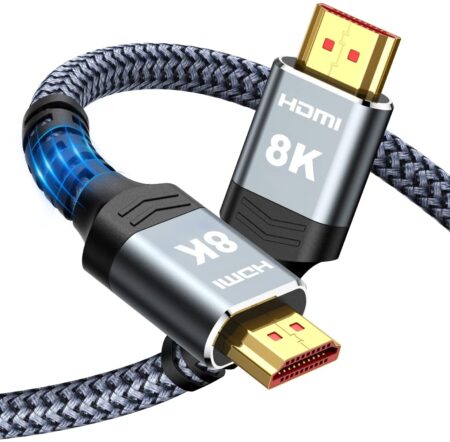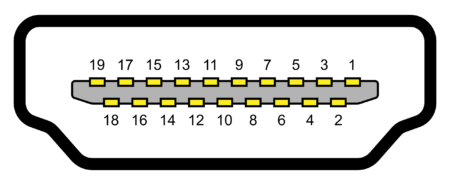HDMI is one of the most common connectors for video and audio interfaces. This versatile interface helps you run high-resolution and high refresh rate displays that the older VGA and DVI interfaces can’t.
But does HDMI carry power along with video and audio signals? The answer is yes, they do carry power. But not enough to power devices like external displays.
In other words, they do not carry power like a USB port. HDMI interface is, in fact, not designed to deliver power.
The power delivered by HDMI is NOT sufficient to run monitors, TVs, PCs, etc.
TABLE OF CONTENTS
How Does HDMI Work?

HDMI cables are among the most popular ways to connect audio and video devices. But to understand why HDMI does not carry power, you must understand how a typical HDMI cable works.
HDMI stands for High-Definition Multimedia Interface. These cables can carry both digital video and audio signals.
The latest and greatest HDMI technology is HDMI 2.1, which can support resolutions up to 8K and data transfer speeds up to 48 Gbps. HDMI cables can also transmit Dolby TrueHD and DTS-HD Master Audio signals.
Most consumer devices use a 19-pin type of HDMI connector. There’s a mini-HDMI connector also available, but the regular one is far more popular.
The signals travel from the HDMI connector’s pins via twisted pairs of copper wire. Six pins transmit three audio and video channels for three cables per channel.
The TMDS (Transition-minimized differential signaling) clock, which allows devices to synchronize the incoming data, travels through one pair of wires.
Each of these four major cable pairs contains a shield which is another wire that protects the neighbor wires from interference.
These are the components that make up the bulk of wires in an HDMI cable. The HDMI connection transmits other signals in addition to video. Because only one pin is necessary per channel, the other signs that travel via the HDMI cable can be sent over a single wire.
The consumer electronics channel (CEC) is one such channel. If your devices support it, this channel allows them to “talk” to each other.
The hot plug detects the channel with only one connection, monitors when you connect or disconnect a device, and re-initializes the HDMI link if required.
The one-pin display data channel (DDC) carries device information and HDCP (high-bandwidth digital copy protection) encryption information. This protects the data traveling through the HDMI cables.
Also Read: Does HDMI Drain Battery?
HDMI Pin Out Diagram
Here is the pin-out diagram of a Standard HDMI connector with 19 pins and what an HDMI Cable look like.

| Pin# | Function | Pin# | Function |
|---|---|---|---|
| Pin 1 | TMDS Data2+ | Pin 11 | TMDS Clock Shield |
| Pin 2 | TMDS Data2 Shield | Pin 12 | TMDS Clock− |
| Pin 3 | TMDS Data2− | Pin 13 | CEC |
| Pin 4 | TMDS Data1+ | Pin 14 | Not Connected |
| Pin 5 | TMDS Data1 Shield | Pin 15 | SCL (DDC) |
| Pin 6 | TMDS Data1− | Pin 16 | SDA (DDC) |
| Pin 7 | TMDS Data0+ | Pin 17 | Ground |
| Pin 8 | TMDS Data0 Shield | Pin 18 | +5 V (50 mA max) |
| Pin 9 | TMDS Data0− | Pin 19 | Hot Plug Detect |
| Pin 10 | TMDS Clock+ |
The only pin that carried voltage is Pin # 18, which has a max current rating of 50 mA. Meaning the maximum amount of power it can take is 0.25W.
So Does HDMI Carry Power?
Yes, HDMI does carry power.
On the other hand, the power in Pin # 18 can be used to power devices.
However, 0.25W of power is insufficient to power up most multimedia devices.
It should be noted that the TMDS channels also carry power. However, the emphasis on these channels is intended for taking the video and audio signals, not powering up devices.
Can HDMI Power Devices?
As mentioned, the maximum operating voltage for HDMI is 5 volts, and the maximum current it can carry is 50 mA over just one pin intended to deliver power to connected devices.
The primary goal of the HDMI interface is NOT to power up or charge devices. This is why external displays have their separate power source.
A typical PC monitor efficiently requires 25-60 watts of power.
But let’s say you want to power something with HDMI. If you somehow cobbled this thing together, it would probably only last a minute before the wires melted, and the whole thing collapsed. It might fry your monitor or computer, or possibly both.
So can HDMI power anything? Well, no.
Unfortunately, no device uses only 0.25W to power up.
Even the lightest multimedia devices, such as the Chromecast, require 1-2 watts or 4-8 times the HDMI port’s power.
Hence, almost all HDMI interface devices require an external power source.
Also Read: Does HDMI Cable Cause Lags?
HDMI 2.1a and Cable Power Feature
In the latest revision of the HDMI version, i.e., 2.1a, a new feature called HDMI Cable Power has been added, allowing supported devices to be connected without needing a separate power cable.
This feature is mainly intended to allow support for active HDMI cables to be powered directly through the port.
However, since this feature can supply 5v @ 300mA, which equals 1.5W, we may have specific and more efficient multimedia devices that use this feature. Or perhaps we may not see any device at all.
Also Read: What is the Best HDMI Port for Gaming?
Final Words
So does HDMI carry power? Yes, the HDMI interface brings power, but it is not nearly enough to power our everyday devices.
There is no device out there, except for the cable itself, that can get powered directly through the HDMI port version even tho pins carry 5VcarryingA max.
This amount of electricity is only enough to allow communication between the devices they are connected to. So, while you won’t be powering any displays with HDMI anytime soon, HDMI is still a versatile connector that can transmit audio and video signals to up to 8K displays and beyond.
FREQUENTLY ASKED QUESTIONS
1. Do HDMI Cables Carry Electricity?
For those unaware, the terms power and electricity are used interchangeably in colloquial language.
However, in technical terms, electricity is the flow of electrical charges measured in ohms.
So yes, HDMI cables do carry electricity of about 50 milli-Amps (mA).
Rest assured if you are worried about electrocuting yourself by touching the HDMI connector. In that case, 50mA is insufficient even to register a faint feeling of electricity running through your body.
2. Is there a risk of damaging my device if I use HDMI to charge it?
There is generally no risk of damaging your device if you use HDMI to charge it.
However, it’s important to note that HDMI power delivery is not optimized for charging, and may not charge your device as quickly or efficiently as other charging methods.
Additionally, using a non-standard cable or adapter could potentially damage your device or cause a safety hazard.
3. What are some common uses for HDMI power delivery besides charging devices?
HDMI power delivery can also be used to power small devices such as HDMI switches, splitters, and converters. It can also be used to power small single-board computers such as the Raspberry Pi, which have an HDMI port that can be used for both video and power delivery.
4. What are some potential safety concerns with using HDMI power delivery?
One potential safety concern with using HDMI power delivery is the risk of using a non-standard cable or adapter that does not meet safety standards.
These cables and adapters can potentially cause electrical shock, fire, or other hazards.
Additionally, using HDMI power delivery to power high-wattage devices such as laptops or desktop computers could potentially overload the cable or port, causing damage or creating a safety hazard.
5. What are some future developments in HDMI technology, and how might they impact power delivery capabilities?
One potential future development in HDMI technology is the implementation of HDMI 2.1, which supports higher bandwidths and resolutions. This could potentially increase the power delivery capabilities of HDMI, allowing it to power larger and more power-hungry devices.
Additionally, there is ongoing research into using HDMI as a power delivery method for electric vehicles and other high-power applications, which could potentially revolutionize the way we think about power delivery.
